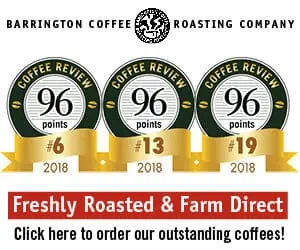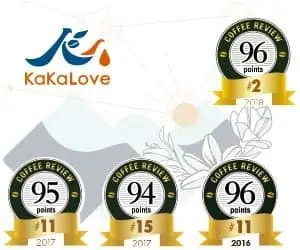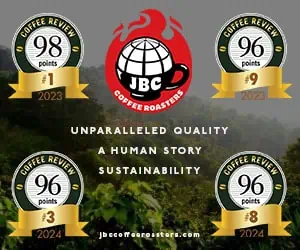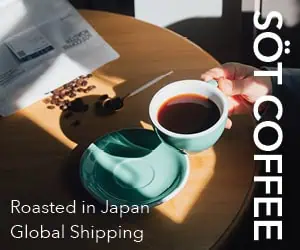How deep a flavor rut are coffee drinkers stuck in if they give up caffeine? Are they eternally condemned to token decaf blends at the end of the counter, or can they tour the world by cup, or try to save it by cup, like their caffeine-consuming colleagues?
Based on this month’s cupping of decaffeinated single-origin coffees, options are rather limited when you travel by decaf. A couple of excellent Sumatras surfaced, including the top-ranked Paradise Roasters (92) and a classic example from Hood River Coffee (88). Sumatras, with their strong, unorthodox, earthy character, tend to take well to decaffeination, which can round and soften their sometimes rough edges.
Among other strong-charactered origins, three decaffeinated East Africas showed up, including a distinctive, exciting, if rather rough Ethiopia Yirgacheffe from Counter Culture Coffee (90) and a Kenya from Roasters Coffee House (86) that took a dark roast nicely, but somewhere along the line lost whatever Kenya-ness it started with.
Some of the most celebrated Latin America origins were either absent or represented by a single submission: the PT’s Costa Rica (88), for example, and The Roasterie Colombia Decaf Pitalito Estate (88), both solid though not exciting representatives of the virtues of their respective origins.
The Peru and Mexico Preponderance
What did appear in considerable quantity were decaffeinated Perus and particularly Mexicos, many of them Fair-Trade certified. There is some irony here, given that both Peru and Mexico are coffee origins more admired for their sweetness, softness and subtlety rather than for the bold character likely to make it intact through the rigors of decaffeination. Choosing to decaffeinate origins best known for their delicacy rather than their power or distinctiveness is a little like choosing a breathy, wispy-voiced cabaret singer to deliver the Star-Spangled Banner through a bad amplification system.
Nevertheless, two of these sweet, gentle coffees survived the decaffeination process with their understated elegance intact. The Arbor Day Mexican Altura (90) is not only delicate and silky in the cup, but all-around progressive outside it: Fair-Trade and organic certified, grown in mixed species shade, benefiting an organization that plants large quantities of trees every year, and, inevitably, decaffeinated by the solvent-free Swiss Water Process.
The Olympia Coffee Roasters Peru La Florida (88) showed a similar quiet appeal, though with a bit less aromatic complexity and, though Fair-Trade-certified, a bit less in the way of environmental correctness. But it did display the quiet, elegant virtues of the origin, which many of the decaffeinated Perus and Mexicos in the cupping did not. Rather than soft and silky, they frequently came across as thin and simple.
Why so many decaffeinated Mexicos and Perus, given their delicacy? Price, perhaps, as both are considered good values by green coffee buyers. Also, it is relatively easy to find Fair-Trade and organic-certified coffees from these origins, and some of the roasters who nominated their coffees for this cupping specialize in certified coffees. Many of the Mexicos and two of the Perus submitted this month were from the new “Mountain Water” water-only-process decaffeination facility in Vera Cruz, Mexico, which not only specializes in decaffeinating Mexicos but also appears to do a lot with Perus.
Cup and Decaffeination Method
Turning to impact of decaffeination of flavor, no clear pattern of superiority surfaced this month among the most commonly used methods: the “conventional” method (uses a solvent), the so-called “natural” methods (use either a more environmentally friendly solvent, fruit-derived ethyl acetate, or liquefied CO2), and the water-and-charcoal filter methods, including both the new Mountain Water Process operated in Vera Cruz, Mexico and the well-established, high-end Swiss Water Process facility in Vancouver. My conclusion after cupping this month’s samples is that the quality of the original green coffee before decaffeination and the care taken roasting it after decaffeination probably have more influence on quality of the final cup than does the method of decaffeination itself. Regardless of method, at a medium roast the hints of woody, raw-nut character associated with decaffeination seemed ready to surface if the original green coffee did not present enough character to transcend it or hold it off. At darker roasts the sin of decaffeination (for all of the processes, I suspect) seemed to be a simple reduction of range and character.
Returning to the question of whether decaf drinkers are well-served by the specialty industry, I find the limited number of single-origin options available to decaffeinated coffee drinkers rather discouraging. I hope the reason is owing to honest economic reasons (limited interest in decaffeinated single-origins among consumers) rather than to the rather macho-tinged dismissal of decaffeinated coffees one often runs into among specialty coffee green buyers and roasters.
2008 The Coffee Review. All rights reserved.










